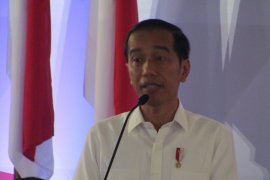Developing human resources is not an easy taskJakarta (ANTARA) - President Joko Widodo (Jokowi) remains resolved to encourage national development from the peripheral areas -- villages -- on account of the presence of 74,961 villages in Indonesia by 2022.
As villages hold majority of the Indonesian population, they would be valuable assets in the efforts to advance national development. Hence, it is also appropriate to say that villages are the face of Indonesia’s development.
To advance development in villages, the Ministry of Villages, Development of Disadvantaged Regions, and Transmigration formed the Village Fund for disbursal to villages to empower and encourage residents to develop their local community.
The Village Fund has been successful in improving the Village Development Index (IDM) of various villages in Indonesia. The index classifies villages into five: self-sufficient, advanced, developing, underdeveloped, and extremely-underdeveloped.
According to the IDM data for the 2015-2022 period, 6,238 villages had the self-sufficient status -- a significant increase from 174 villages -- and surpassed the target of five thousand self-sufficient villages set in the 2024 National Middle-Term Development Plan.
Indonesia currently has 20,249 advanced villages, an increase from 3,608 villages, and 33,902 developing villages, which increased from 22,822 villages. Meanwhile, Indonesia successfully reduced the number of underdeveloped villages, from 24,008 to 9,548, and extremely-underdeveloped villages, from 13,453 to 4,982 villages.
Moreover, Bali, Yogyakarta, West Java, East Java, and Bangka Belitung Islands are the five provinces that successfully eradicated the extremely-underdeveloped status for villages from their regions.
Responding to the positive record of village development in Indonesia, Minister Abdul Halim Iskandar said it proved that Village Fund had been utilized properly by village authorities.
The success in villages also dismissed doubts about the capability of village authorities in managing the Village Fund, let alone by the success in maintaining the positive performance in improving village conditions amid the COVID-19 pandemic.
Meanwhile, the ministry-conceived IDM has become a good indicator for the central government in determining village conditions to decide the amount of Village Fund that will be allocated to a village.
The minister said that villages, with self-sufficient status, would receive more Village Fund disbursement, as more developed villages will face more complex issues to increase the quality of human resources.
“Developing human resources is not an easy task, (and so the decision was taken) to increase the Village Fund allocation. It will be more complex than infrastructure and physical development,” Iskandar stated.
The ministry recorded that as of December 14, 2022, some Rp62.12 trillion (US$3.97 billion), or equivalent to 91.35 percent of the Village Fund budget in 2022, had been disbursed to 74,938 villages, or more than 99 percent of all villages in Indonesia.
In detail, Rp20.95 trillion (US$1.34 billion) of the fund had been allocated as social assistance for 7,303 million residents, while Rp2.07 trillion (US$132.4 million) was used to employ 906,402 residents in labor-intensive village works and Rp4.97 trillion (US$318 million) allocated for COVID-19 handling programs.
In addition, Rp10.73 trillion (US$686.7 million) was utilized for food resilience programs and Rp23.40 trillion (US$1.49 billion) used to fund other village priority programs.
Meanwhile, the Village Fund had been used to develop 3,166 kilometers of village roads, 19,012 meters of bridges, 492,722 irrigation units, 1,729 retaining walls, 36 boat moorings, 42 ponds, as well as to fund 82 village-owned enterprise projects.
Moreover, a total of 310,089 meters of drainage system, 195,208 clean water installation units, 2,380 wells, 581 sanitation facilities, 377 village health centres, 297 early-age education centre activities, and 220 sports facilities had been developed by the Village Fund.
In response to President Jokowi’s determination to develop Indonesia from villages, the ministry also decided on the Sustainable Development Goals (SDGs) for villages as a guide for village development. The Village SDGs comprise 18 goals in the village social, institutional, and territorial development aspects.
The ministry recorded that some 36.69 percent of Indonesian villages decided to use this year’s Village Fund to achieve the first Village SDGs goal of zero-poverty village.
“Consensus reached in villages mostly decided to prioritize achieving the first Village SDGs, which is to (realize) zero-poverty village,” Iskandar remarked.
Meanwhile, some 16.61 percent of villages were aimed at realizing the third Village SDG of a healthy and prosperous village, followed by 11.95 percent of villages aiming for the second Village SDG of hunger-free village, and 10.07 percent of villages decided to realize the ninth Village SDG on developing village infrastructure and innovation.
The minister expressed optimism that Village SDGs would motivate villages to “Think Globally and Act Locally” by having a global outlook while contributing to positive aspects for their local community.
“Hence, (villages) will have a macro-level outlook while their contribution will be on the micro-level, which means at the village level,” Iskandar remarked.
The Village Fund has been successful in its objective of developing villages to become more economically and socially advanced. The positive performance of the Village Fund allocation also proved the administrative capability and willingness of village authorities and residents to lift themselves out of underdevelopment.
The Indonesian people expect village residents to continue to participate in ensuring the Village Fund will be utilized for their best interests to realize prosperity in villages and ensure national development will reach the village level.
Related news: Village funds can help build disaster resilient communities: ministry
Related news: Gov't helping villages manage unused COVID handling funds: ministry
Related news: Village Fund for food resiliency reached Rp8.06 trillion: Minister
Translator: Zubi Mahrofi, Nabil Ihsan
Editor: Sri Haryati
Copyright © ANTARA 2022












